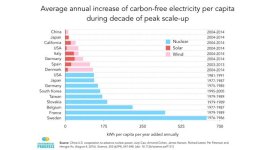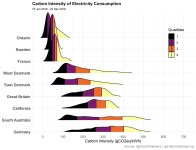I didn't want to fly – so I took a cargo ship from Germany to Canada | Travel | The Guardian
As the ship’s immense hull came into view, I entered a world where everything was larger, louder and more dangerous than my life on land. The 300-metre, 100,000-tonne vessel before me was to be my home for the next 15 days.
Since 2017, I’d emitted over 14 tonnes of carbon from flights alone. I realised that all my efforts to reduce my carbon footprint at home in Milan – I cycle to work, limit food waste and seldom buy new clothes – are wiped out by just one flight between Canada and Europe.
The only steam engines still in use for water vehicles are those that are powered by nuclear reactors. Everything else that's bigger than a motorboat is powered by diesel engines, and for big ships, big diesel engines. Ships usually use bunker fuel or heavy fuel oil, what's left after everything distillable has been distilled off from crude oil. It's a bottom-of-the-barrel fuel in a very literal sense.
I anticipated a long and tiresome journey (I packed dozens of books and downloaded films) and had visions of gruelling nights spent with my face in a barf bag, but my experience on board could not have been more enjoyable. The two other passengers, Tony from the Netherlands and Janos from Germany, were hitching a ride for the same environmental reasons and their company made time fly by. Our cabins were simple and comfortable, each with private toilet and shower, two single beds, a desk and vast ocean views. The 25 crew members, a mix of Filipino and eastern European men, were warm and friendly. I was in all-male company for my transatlantic voyage but Isabel Hagen, a Swedish student I met through a friend, made the voyage earlier this year, and said she’d had a positive experience as a solo female traveller: “The crew was welcoming, respectful, and polite from the moment I stepped on board.”
The ship started off in Hamburg, Germany, then docked in Antwerp, Belgium, and Liverpool, UK, spending a day at each place.
It had some 4,000 shipping containers and six "roll on, roll off" decks for vehicles. Thus acting like a car ferry.
From Halifax, the author went by overnight train to Montreal, spending a night there, then Toronto, spending another night there, then a train called The Canadian to Vancouver BC.
As on the ship I was immediately struck by the hospitality of the crew – servers and attendants who seemed genuinely happy to be there despite being thousands of kilometres from home. The food was impressive as well, like the brunches of fluffy buttermilk pancakes drowning in the maple syrup that I’d missed so much in Europe. Dinners of hemp-crusted trout, roast veal chops and fresh vegetables were equally delicious. The atmosphere among passengers was jovial, with communal mealtimes and a rowdy bar where we swapped travel stories.
As on the ship, the vast expanses passing by my window made the journey special: the endless boreal forests of northern Ontario, the icy, placid prairies and the magnificent Rockies in the west, every landscape shimmering under mid-December snow. Sitting in the dome car watching a blazing sun set over white Quebec forests and waking to whiteout blizzards in Manitoba deepened my connection to the land I call home, and reaffirmed my commitment to protecting this natural beauty.
The journey was about 13,000 km, breaking down as 7,000 km by ship and 6,000 km by train. The ship part cost about EUR 100 per day.
Carbon emissions (according to weight of passenger)
Flight Frankfurt-Vancouver: 1.3 tonnes*
Cargo ship Hamburg-Halifax (via Antwerp & Liverpool): 5.3kg**
Trains Halifax-Vancouver: 204.2kg***
Total CO2 Hamburg to Vancouver: 209.5kg
* myclimate Foundation
**International Council on Clean Transportation
***Via Rail
It's all fossil fuel, but this trip shows how to use less of it. Go by surface vehicle instead of by air.
The best for being renewable-powred is electric trains, and all the rest will need cost-competitive synfuels to be feasible. There is a lot of work on those, but they are still not there yet. But when they are, they will make possible zero-carbon aviation as well as zero-carbon shipping and zero-carbon diesel trains and buses and trucks.


